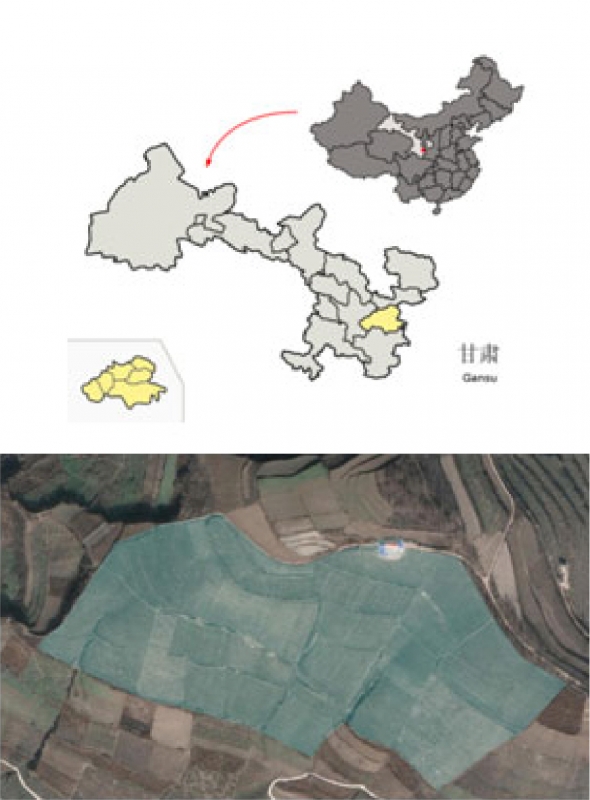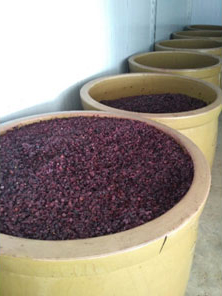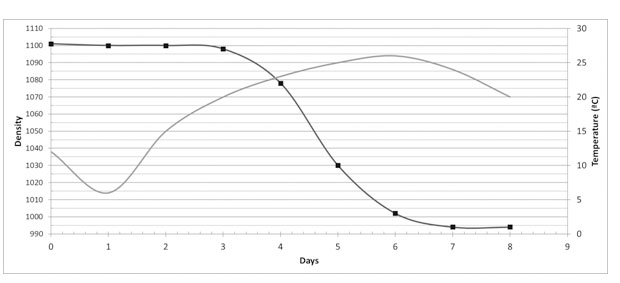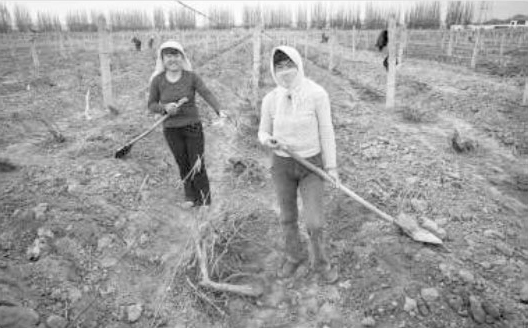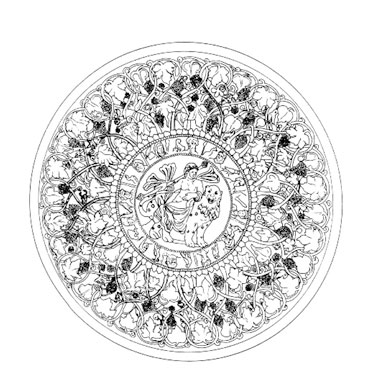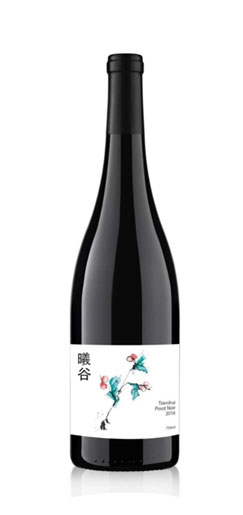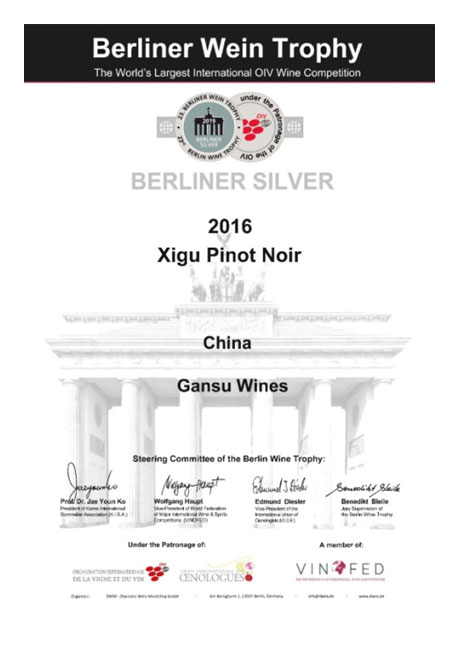This work has been a leap of faith supported by countless individuals in diverse ways. However, we feel we should honor those whose direct moral and financial support to our effort has made this work possible, namely the investors, partners, and associates of M. Boutari & Co Ltd. to whom this paper is dedicated.
Introduction
If Yinchuan has often been likened to Napa Valley, in the future Tianshui could very well become for China what Beaune is for France. China has become today one of the top five wine countries in the world not only in terms of consumption, but also of production. Nonetheless, the overall knowledge base and practices of the domestic wine industry are arguably still subpar by global standards. This paper presents the findings of our decade-long applied research & development to contribute to the raising of awareness both among local and overseas wine professionals about the nascent appellation system in China and in particular about the potential to grow great Pinot Noir in Tianshui, Gansu Province.
Recently, the booming wine industry (at least as regards investment) around Yinchuan City, Ningxia Province, stands out as the leading wine region of China. Our exploratory work has showcased an alternative wine region about 700km to the South in the Maiji District of Tianshui City, Gansu Province (Figure 1). This paper expounds on the viticultural and socioeconomic ramifications of this sweet spot in China to produce Pinot Noir of world-class quality.
Figure 1: Map of Tianshui and satellite view of the pilot M. Boutari& Co Ltd vineyard.
Overview of Climate Cardinal Constraints for most of China’s winegrape-growing regions
Most Central, Eastern, and Southern Provinces in China have very wet and warm summers, which make it extremely challenging to grow wine grapes of high quality by global standards. An exception to this general phenomenon is the “XiBei” outback (literally “WestNorth” in Chinese), consisting of the vast Northwest regions of Mainland China, which enjoy abundant sunshine during the summer. The Western and Central parts of Gansu Province, like Inner Mongolia, Ningxia, and Xinjiang, are all parts of the XiBei with grape-growing areas, and share the major advantage of abundant sunshine during the summer. However, being an alpine desert zone for the most part, the highlands of XiBei have the acute disadvantage of prolonged sub-zero temperatures during the winter forcing seasonal vine burial to prevent root death due to soil frost (Appendix 1).
As a result, while vines in most of the areas of XiBei attain sufficient technological maturity during a short, accelerated, and very hot growing season, acidity deteriorates rapidly during ripening due to extreme heat. More importantly, phenolic maturity tends to be problematic due to the bush-vine canopy system forced by vine burial. Even in well-trimmed vineyards that are privately grown by estate-grown wineries, a large share of the fruit load ends up coming from secondary or tertiary shoots from latent buds. Secondary crop from lateral shoots is a common problem in cold-climate viticulture and has been linked to lower berry/bunch weight and inadequate/non-uniform fruit maturity derived from physiological deficiency related to inflorescence primordia1. This is hard to macroscopically spot in XiBei grapes because the strong sunlight ensures a satisfactory veraison, but a characteristic “stalky” flavour of green leaf volatiles can be spotted in varying degrees in most wines from XiBei.
Furthermore, while some varieties (e.g. Carmenere or Cabernet Sauvignon) may have shown satisfactory results in some cases, it is extremely rare, if at all possible, to make a consistently remarkable Pinot Noir. Another wine growing region with sunny summers beyond the XiBei is the sweet spot of Shangri-La, in the highlands of the Southwest Provinces, where AoYun, an LVMH joint-venture project, has produced an impressive result with Cabernet Sauvignon. There is also a new project recently launched nearby with Pinot Noir that should reach production stage in a few years.
Distinguishing Characteristics of the Tianshui Macroclimate
In Tianshui vine burial can be avoided because it has the mildest winters of XiBei. Tianshui is exceptional because it is located in the Eastern edge of Gansu Province, that has the only untypically temperate macroclimate in China, which combines sufficient summer sunshine and mild winter temperatures at a subalpine altitude. The absolute minimum temperature is not too low and even if it does drop at critical levels, it does not last continuously for too long, so it does not lead to soil frost [Table 1 and Appendix 2 (Tables 1a-h)]. Summer drizzle and in some years heavy rain can be frequent and long-lasting, but the risk is manageable primarily because diurnal temperatures are not too high. The high altitude plays an important cooling role: the altitude of Tianshui city is 1.171m, while the vineyard is located at a hillside with an altitude ranging from 1.250-1.400m. The South latitude in combination with the high altitude endow the grapes with a typical varietal aromatic profile and an untypically dark colour for Pinot Noir.
Table 1: Weather data 2005-2010: Average monthly data.
| Month | Rain (total in mm) | Sunshine hours per day | Sunshine (%) | Mean Temp. (ºC) | Mean Max. Temp. | Mean Min. Temp. | Absolute Max. Temp. | Absolute Min. Temp. |
| January | 2,1 | 4,2 | 41,5% | -1,8 | 4,7 | -6,6 | 14,7 | -10,6 |
| February | 6,9 | 4,5 | 41,4% | 2,3 | 8,7 | -2,3 | 21,4 | -7,5 |
| March | 18,6 | 5,9 | 49,2% | 7,9 | 15,3 | 2,2 | 29,9 | -2,8 |
| April | 23,5 | 7 | 53,8% | 13,5 | 21,3 | 6,6 | 32,1 | 2,9 |
| May | 58,8 | 7,1 | 51,3% | 18,3 | 25,7 | 11,7 | 33,2 | 11,6 |
| June | 63,8 | 7 | 48,9% | 21,5 | 28,7 | 15,3 | 36,3 | 14,4 |
| July | 117,7 | 6,5 | 45,7% | 23,2 | 29,3 | 18,2 | 35,1 | 18,5 |
| August | 97 | 5,1 | 37,8% | 21,8 | 27,5 | 17,3 | 35 | 15,3 |
| September | 72,7 | 3,9 | 31,2% | 16,9 | 22,3 | 13 | 30,4 | 10,2 |
| October | 47,4 | 3,9 | 34,3% | 11,6 | 17,7 | 7,4 | 26,6 | 4,1 |
| November | 9,2 | 4,6 | 44,2% | 5 | 11,9 | 0 | 21,6 | -6,5 |
| December | 2,3 | 4,5 | 46,0% | -1 | 5,9 | -5,9 | 14 | -6,9 |
At such high altitude, grape maturity could be indeed a challenge; however, as in the case of the SouthWest highlands of Shangri-la, the quite South latitude (34,3052.3) more than compensates for the chill of the high altitude with a highly intensive sunshine. The growing season in Tianshui is roughly one month longer than all other wine growing regions of XiBei. The result is a slower maturation with consistently preserved natural acidity regardless of the final maturity level of the grapes. This freshness allows for the characteristic Pinot Noir flavours and aromas to flourish; however, the Tianshui macroclimate proved too cold for Cabernet Sauvignon, Cabernet Franc, and Merlot to ripen at a satisfactory level.
The venture to test the other “terroir” parameters of Tianshui apart from its macroclimate
Venture Context
There have been two prior attempts to establish a wine industry in Tianshui: one government-led in the 1960’s, which was aborted, and one by a German private initiative to establish a vineyard in a nearby valley, which also failed. However, a major grape and wine company, Wei Long, has been growing thousands of acres of table grapes in the valleys of Tianshui for over a decade prior to our venture. Site screenings commenced in 2008, weather data was collected in 2010, and the pilot stage of the venture culminated in the first vintage of 2016 having been released and sold out in 2018. A state-owned cooperative, Mogao, initially facilitated the venture launch by jointly establishing in 2010 Gansu Moen Estate Wine Co Ltd, a Sino-Hellenic JV to set up the pilot vineyard, but abandoned it in 2013. Following two changes of corporate structure, the venture is currently privately held as a subsidiary of M. Boutari & Co Ltd. The land use was secured with a 35-year lease through a direct government contract in 2011. The project is a private and independent initiative without any control or support from any government or academic institution.
Site, soil & grapevine
A south-facing slope was sought to minimize the risk of spring frost, which does sometimes occur in Tianshui. While there are several vineyards planted on the valley floor, the selection of a hillside site is imperative not only to prevent damage from spring frost, but also from summer flooding, which is also not too rare. Proximity to industrial or urban zones was precluded. The hillside finally chosen to plant the vineyard is one among the thousands similar to it found along the Loess Plateau. The loess soil type consists of a deep and rather homogeneous silt. The particular loess of the vineyard is characterized by moderate alkalinity and satisfactory organic matter. Planting began in 2011 at a plot of 13,5 hectares and has been continuing with a series of replantings to overcome several setbacks due to experimentation and insurmountable challenges of effectively managing inexperienced local staff. A variety of plant material from several sources, grape varieties, and types of rootstock were used (Table 2). The vineyard is trained in a standard trellis with a double or single vertical shoot positioning (Image 1). The scarcity of reliable vine nurseries in China with certified plant material proved to be one of the most pernicious and expensive obstacles to proper, as well as time and cost-efficient vineyard establishment.
Human Factor
Gansu is the only place in China with relics of classical wine culture (Appendix 3). Tianshui has a rich mythological heritage linked with agriculture (e.g. it is allegedly the birthplace of FuXi). But in spite of it being the terminus of the Silk Road in times bygone, the geographical isolation of Tianshui resulted in a lag of its development. Thanks to massive infrastructure projects, it is today a bustling 4th-Tier city connected with modern highways, regular flights, and high-speed trains with metropolitan centers like Xi’an, Chongqing, Tianjin, and Nanjing. Nonetheless, the local government has yet to allocate sufficient resources to developing the local wine industry as a sector of high priority. Moreover, the villages around the vineyard are abandoned day by day with fewer and fewer young people staying behind with any commitment whatsoever to farming. Old farmers have low productivity and cannot acquire new skills. Most seasonal labor consists of female workers. This situation, in combination with the lack of highly-skilled labour in the local market and the limited financial resources available for this pilot venture, hindered the project, especially during its early years. The attraction of a local professional vineyard technician and professional grape growers in 2018, as well as the access attained to world-class winemaking facilities as of 2019 suggests that significant progress will be made possible in the coming years to further accelerate, scale up, and upgrade production.
Table 2: Planting Log; * (to be confirmed).
| Variety | Source | Year | Area (Ha) | Year Uprooted | Year replanted (with PinotNoir) | Source |
| Cab. Sauv. | Yantai | 2011 | 0,56 | 2016 | 2017 | Yinchuan |
| Merlot | Yantai | 2011 | 2,2 | 2018 | 2019 | * |
| Pinot Noir | Wuwei | 2011 | 0,87 | |||
| Pinot Noir | Yantai | 2011 | 0,37 | |||
| Pinot Noir | Wuwei | 2012 | 0,22 | 2014 | 2017 | Yinchuan |
| Pinot Noir | Wuwei | 2012 | 0,35 | 2016 | 2017 | Yinchuan |
| Pinot Noir | Wuwei | 2012 | 0,74 | 2019 | 2020 | * |
| Pinot Noir | Wuwei | 2012 | 3,56 | |||
| Pinot Noir | Yinchuan | 2012 | 0,91 | |||
| Pinot Noir | Yinchuan | 2013 | 0,38 | |||
| Pinot Noir | Wuwei | 2014 | 1,32 | 2016 | 2017 | Yinchuan |
| Pinot Noir | Yinchuan | 2017 | 0,16 | |||
| Pinot Noir | Yinchuan | 2018 | 1,65 | |||
| Total | 13,29 | |||||
Image 1: General view of the vineyard.
Materials & Methods
Data
Visits were made to major wine growing areas of China between 2008-2010. Information about the macroclimates of China were taken from Atlas of China2. Solar radiation from satellite imaging was also evaluated (Figure 2). Detailed daily climate data (including absolute and average min/max temperature, precipitation, % sunshine, and sunshine hours) between 2005 and 2010 was sourced from the local state meteorological station and grouped by us for monthly averages in 2010 (Table 1 and Appendix 2). Daily observations during the growing season were recorded by the vineyard manager from 2014-2018, that generally confirmed the pattern of macroclimate deducted from the meteorological data. Soil samples were taken in 2010 and analyzed at Agrolab SA in Athens, Greece (Table 3). Wine analysis was done at Ampelooeniki Ltd, a certified wine lab in Greece, for the 2015 and 2016 vintages, while the 2017 wine was analysed at a local lab in Yinchuan, Ningxia (Table 4). For the 2016 vintage that was commercially distributed, an official analysis by a state lab in Ningxia was performed, as well as a safety test for residues at Agrolab SA.
Figure 2: Map of China Direct Normal Solar Radiation.
Table 3: Soil analysis.
| Test / depth | 0-30cm | 30-60cm | 60-90cm | units | method |
| Sand | 13.3 | 11.3 | 9.3 | % | Bouyoucos, 1962 |
| Silt | 62 | 58 | 58 | % | Bouyoucos, 1963 |
| Clay | 24.7 | 30.7 | 32.7 | % | Bouyoucos, 1964 |
| pH | 8.3 | 8.1 | 8.1 | 1:2 water | |
| Total CaCO3 | 15.3 | 13.17 | 13.22 | % | volumetric |
| Active CaCO3 | 4.2 | 3.1 | 2.8 | % | Drouineau, 1942 |
| Organic matter | 2.2 | 1.9 | 1.6 | % | wet oxidation |
| El. Conductivity | 0.35 | mS/cm | saturation water | ||
| Magnesium (Mg) | 334 | mg/Kg | NH4 AoC, pH 7 | ||
| Nitrogen (NO3-N) | 2.5 | mg/Kg | 1N KCL | ||
| Phosphorous (P) | 2.05 | mg/Kg | Olsen | ||
| Potassium (K) | 154 | mg/Kg | NH4 AoC, pH 7 | ||
| Copper (Cu) | 1.07 | mg/Kg | DTPA | ||
| Zinc (Zn) | 0.57 | mg/Kg | DTPA | ||
| Manganium (Mn) | 11.08 | mg/Kg | DTPA | ||
| Iron (Fe) | 5.2 | mg/Kg | DTPA | ||
| Boron (B) | 0.52 | mg/Kg | boiling water |
Table 4: Analysis of the Pinot Noir wine over three vintages.
| 2015 | 2016 | 2017 | ||
| Alcoholic strength by volume | 12,7 | 13,3 | 11,5 | % vol |
| Density | 0,9921 | 0,9909 | 0,9927 | gr/L |
| Reducing substances | 1,8 | 1,5 | 1,7 | g/L |
| Volatile acidity | 0,28 | 0,32 | 0,21 | g/L Acetic acid |
| Titratable acidity | 6,7 | 6,2 | 7,4 | g/L Tartaric acid |
| pH | 3,37 | 3,44 | 3,31 | - |
| Free Sulphur dioxide | 9 | <3 | <3 | mg/L |
| Total Sulphur dioxide | 43 | 10 | 25 | mg/L |
| Tartaric acid | 3,6 | 3 | 3 | g/L |
| Malic acid | 1,1 | 1,2 | 1,9 | g/L |
| Lactic acid | <0,3 | <0,3 | <3 | g/L |
| Colour intensity | 13,94 | 10,54 | 5,76 | au |
| Hue | 0,46 | 0,59 | 0,49 | - |
| Phenol index | 51 | 40 | 30 | au |
| Total anthocyanins | 507 | 313 | 277 | mg/L |
| Tannins | 3,9 | 1,4 | 1,1 | g/L |
Viticultural Notes
Planting, irrigation, weed control
As a field preparation, deep plowing was not possible in the narrow terraces of the hillside terrain. An excavator was bought to dig 1m-deep trenches along the vine rows and turn over the soil after adding a mix of sheep manure, straw, and inorganic fertilizer. Irrigation is not necessary except for new plants, since winters are very dry and there is more than sufficient rain during spring and summer. White grapes were not tested for two reasons: the high upfront cost of making a reliable example of a wine trial made in small batches, as well as the very low demand for white wine in China; however, it is quite possible that varieties like Riesling or Chardonnay could produce very interesting outcomes.
Due to an infestation by moles, a sizeable number of vines died between 2012-2014. Similar attacks to neighboring apple orchards led to an invention by the locals of a simple contraption following the failure of all chemical or mechanical attempts to control the pest. As of 2016, a soft iron net (wire thickness of 1mm at a weaving dimension of 5x5cm) was used to create “baskets” inserted in the vine holes prior to planting the seedlings. There seems to be no signs of mole attacks any more.
Weed control is a serious issue, primarily because of the lack of mechanization. The prohibiting cost of importing a specialized viticultural tractor left no choice other than manual treatment. But manual control is not possible during rainy days, even if there is only a drizzle. In Tianshui the drizzle could last for 2-3 days in a row with a short break and then start again. This implies that weeds grow at an exponential rate. The problem with the soil type of the vineyard is that silty slopes permit practically no traction to any rubber wheel. A regular tractor made by a Chinese factory gets stuck, so the vineyard during a large period of the growing session could only be accessible by a caterpillar tractor or a drone. Neither of these two machines has been available until now.
Canopy Management, crop load, disease & pest control
About 44 cement poles were used per Mu (roughly 660 per Ha). Each pole was 2m long as is usual in China. In retrospect, they should be a bit higher. They are easily installed not too deep without any special tools, as the silt softens easily with water and hardens a lot when dry. Three wires were used: single line at the first one at a height of 60cm, and double lines for the second and third ones at 100cm and 160cm respectively. Thinning of all lateral shoots was done every spring and tipping in the summer at a height of around 180cm as per usual farmer practice in the area despite instructions to raise the canopy height. During the 2015 vintage only one bunch per cane was left after a green harvest shortly after veraison.
The vineyard enjoys a breeze moving from the West to the East almost every day. However, it is not enough to mitigate the risk of fungal disease. Powdery mildew, downy mildew, and botrytis have proven to be extremely dangerous, if left unchecked. A protocol of alternating Bordeaux mix, sulfur dust spray, as well as agrochemicals by local Chinese industries, as well as the Syngenta subsidiary in China, has proven effective in years without severe pressure. In years with light disease pressure like 2015 and 2016, 4-5 applications were sufficient. However, in difficult years with erratic weather patterns like 2017 and 2018, a weather monitoring station with more precise and real-time data alerts, as well as a system of spraying timely the entire vineyard even in wet conditions (e.g., a caterpillar tractor with a cabin or a squadron of drones) are both required. The lack of daily local monitoring and advice by a skilled agronomist/horticulturalist proved fatal for both vintages in 2017 and 2018. Furthermore, even if we had such a timely data input, our manual system, reyling on 4-5 farmers spraying by electricity-powered backpack sprayers, would have proven insufficient anyhow, as they would remain idle due to the conditions of frequent rainfall.
Moles pose a serious threat, but the iron net baskets protecting the rootzone applied upon planting the vine seedlings has proven to be an adequate measure to control them. An endemic insect that overwinters in buds also caused a serious issue during the first years until identified and controlled with timely applications of a non-specific insecticide. Damage from other insects has not been noticeable. Rabbits, birds, and bees are present and do nimble berries close to harvest time, but are insignificant threats to production. No large mammals are found. No research on nematodes was done. Virus infestation is present, especially in the vines sourced from Wuwei that came from cuttings of Mogao vineyards.
Winemaking notes
The winemaking protocol was based on Spanish traditional methods adapted to the winery conditions: the limited resources on staff, water, and electricity, as well as the sheer lack of machinery. The experience of the winemaker in handmade methods in Spain was vital allowing us to make a complete and thorough processing without any machinery and with just a few workers. The low quantity of grapes processed in the first trials also made this possible, so as to make the wine “naturally”.
Image 2: 600 Lt. Clay pots (Fermentation vessels).
After weekly monitoring of sugar and acidity during the summer and setting the target at 22 Brix, the harvest date was fixed. It must be noted that the harvest date had to be adjusted according to the unpredictable climatic conditions (frequent shower rains during autumn); once the sunny weather windows were confirmed, the amount of grapes for harvesting was set at 500 kg/day to give enough time to destem them by hand. Whole-berry grapes were deposited in clay vessels (600 Lt.) (Image 2). Cold maceration was performed for 24 hours adding dry ice every 6 hours to keep the temperature under 6 ºC and oenological enzymes were added. After that time we let the temperature raise naturally and added the yeast once temperature reached 15 ºC. Daily head plunging (pigeage) and mild aeration was conducted manually as a standard process. Intensive aeration was also made, if needed. The clay vessels kept the temperature under 26 ºC throughout the fermentation without external help (Graph 1). Grapes were crushed after the third day of fermentation. The separation of the wine from the solid pulp was made just under the density of 1010 to avoid green tannin extraction. Soft pressure was applied (no more than 60% of wine was obtained). Neither filtration nor fining was performed. The winery temperature in wintertime provided perfect conditions to get natural clarification by temperature alone. Sulphur was controlled during all the winemaking process.
Graph 1: Average Fermentation/Temperature curve over three years (2015-2017).
Results & Discussion
Overall weather and viticultural report
Three pilot-scale vintages were produced at a basic on-site crushing facility. The only one bottled was the 2016 vintage. We managed to bottle about1.200 bottles (Table 5). We sold all of them through an online Shanghai-based distributor at a comparable price level with generally available imported Pinot Noir. A team of four persons worked full-time and part-time for local administration, vineyard management, and winemaking. All processing was always based on minimal interventions, so the wine can be called “natural”. Extremely low levels of sulphites were added. The name chosen for the branding of the wine was “XiGu”, which could be liberally translated as “the valley in the light of dawn” (Appendix 4). The first vintage release was received with great enthusiasm by a community of discerning wine consumers all over China and mentioned positively by wine press both locally and internationally [Silver medal in the Berlin Wine Trophy, XiGu 2016 (Appendix 5) and positive reports given among others by Jancis Robinson: “Deep, healthy mid garnet. Sweet, pleasant nose does not immediately communicate varietal flavor but it’s a nicely balanced wine without excess, even without massive Pinot character. A little spice and some obvious oak influence. Not that long but a good start! There’s a certain delicacy to this wine. Great to encounter an ambitious Chinese red that is nor a copy of a Bordeaux”]. The wines of each vintage reflect not only the weather conditions of each year, but primarily the efficacy (or lack thereof) of the viticultural practices. A brief evaluation of the last six years is as follows:
- 2013: no harvest with a 30-year record-high heavy rain during the summer leading to excessive weed growth causing low survival rates or stunted growth to a large number of vines
- 2014: no harvest with moderately wet summer
- 2015: first harvest in a great year with abundant sunny days nicely balanced between overcast and rainy days leading to perfectly healthy and ripe grapes with overall dry conditions all the way up to crush
- 2016: second harvest in a great year similar to 2015, only a bit more wet leading to a slight dilution due to berries of higher weight. Improvements in the basic winery facility and the experience of the previous harvest contributed to an even better end result in the wine
- 2017: third harvest with an unusually dry August giving way to a massive outbreak of powdery mildew that took us by surprise and gave way to a severe botrytis infection and sour rot during a relatively wet September with excessive weed growth. An otherwise great year turned out to be a disaster, but also an opportunity to test the production of sparkling wine, which proved very encouraging despite the lack of suitable processing equipment
- 2018: fourth harvest with a very wet spring, when we failed to control downy mildew due to lack of mechanization leading to a sharp production drop and a strange suboptimal cluster condition (nice and healthy berries next to dried up dead berries). No crush on site, grapes handed over to a COFCO winery in Ningxia
Table 5: Harvest yields per year and grape variety
| Pinot Noir | 2015 | 2016 | 2017 |
| Grape Production (Kg) | 1.000 | 2.100 | 6.000 |
| Wine (HL) | 6 | 1.6 | 6 |
| Dry red wine (bottles) | 0 | 1.200 | 0 |
| Sparkling rose wine (bottles) | 0 | 0 | 600 |
| Cabernet Sauvignon + Merlot | 2015 | 2016 | 2017 |
| Grape Production (Kg) | 2.400 | 1.000 | 0 |
| Wine (HL) | 1.6 | 7 | 0 |
| Dry red wine (bottles) | 0 | 0 | 0 |
Winemaker report
The Tianshui terroir allows Pinot Noir to advance its grape ripening, as the hours of sunshine are adequate (Table 1) and the inclination of our vineyard favours the reception of the illumination (Image 1). The grapes reach 22-23 Brix, but the acidity drops very slowly due to humidity. Canopy thinning in late spring and lower leaf removal in the summer help the maturation. Neither fertilization nor irrigation is needed. Berry size is generally a bit larger than usual in other typical areas. Grape skins reach maturation without problems, tannins are soft, pulp is fruity, seeds rarely reach the final maturation stage, but this is easily solved in the winemaking process (see winemaking protocol).
Regarding the wine, the handmade procedure, the cold maceration, and the early separation of the solid pulp altogether enhance the deep ruby colour with soft tannins (darker than in other typical cool areas of Pinot Noir). The fermentation in the clay pots speeds up the fermentation, while keeping the temperature low, so the wine retains its fruity aromas, especially those of red and black fruit. Both characteristics suggest that the wine would improve after 6-10 months in oak barrels without compromising on either colour or aroma.
Operational report
Vineyard mechanization is key to unlocking the potential of Tianshui as a great wine grape growing region. The use of agricultural drones, as well as robotic weed mowers has been suggested as an alternative to a caterpillar viticultural tractor, which can currently be only imported given the absence of an equivalent, unfortunately not yet made by the domestic Chinese industry. Mechanization is essential to controlling both weeds and fungal disease, which are the two major threats to successful wine grape growing in Tianshui. Once mechanized, production can scale up, as well as become efficient thanks to precise and timely intervention. In extremely wet years, which could come roughly once or twice every decade, ripening will be more difficult, and the option of diverting some of the grapes to sparkling wine production could be an option to consider.
Conclusion
The results of the four growing seasons suggest that the original hypothesis about the suitability of Tianshui as a wine grape growing region is reasonable. In particular, there are strong indications that the adaptation of Pinot Noir is excellent, while Tianshui seems to be unsuitable for Cabernet Sauvignon, Cabernet Franc, and Merlot. The failure of the last two vintages to replicate the output of the first two vintages is attributable to poor viticultural practices due to operational issues, most notably the lack of adapted mechanization and precision agriculture. These issues are addressable and can be overcome with additional financial resources and competent local management.
Significant progress is expected in the coming years in Tianshui, which will hopefully witness more investments also by newcomers in the area, as well as more support from the local and central governments for sustainable development through this competitive advantage of its unique terroir. The wine made at the M. Boutari pilot vineyard in Tianshui incorporates features of Pinot Noir’s from both the “New” and the “Old” world. This twofold characteristic of the XiGu Tianshui Pinot Noir could eventually on the one hand place it on the world wine map as a promising new wine region for Pinot Noir for this unique “best-of-both-worlds” feature, and on the other hand showcase it as an example of a pioneering, if not the best, Pinot Noir from China.

